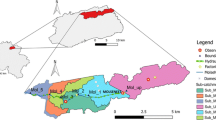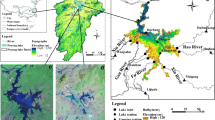Abstract
Roughness is an important parameter in hydrodynamic and water quality modelling; it has direct effects on bottom shear stress which relied on sediment and vegetation. The varied roughness caused by spatial heterogeneity of sediment and vegetation may lead to uncertain simulation results. To investigate the effect of roughness uncertainty on the performance of hydrodynamic water quality models, a typical large shallow lake in China (Lake Taihu) was divided into eight areas for illustrating the effect of spatial variation of roughness on hydrodynamics and water quality. Total nitrogen (TN) was selected as the variable to calculate the uncertainty interval, and sensitive positions greatly affected by roughness as well as the appropriate range of roughness were explored by means of regional sensitive analysis (RSA). The results showed that roughness had the most significant effect on the bottom velocity. The uncertainty for water quality caused by roughness presented a striking spatial difference; the uncertainty interval for TN could be up to 1.3 mg/L. The posterior distribution of roughness was given to further narrowed the range of roughness, and the updated roughness range manifested that roughness value should be set higher in the area with thick sediment and abundant vegetation. It is of utmost importance to consider the comprehensive effects of sediment and vegetation in the determination of roughness. For certain lake areas with great water quality simulation error, the error could be effectively reduced by setting spatial distributed roughness. The optimization scheme was provided for the reasonable determination of roughness, so that the dynamic characteristic at the sediment-water interface could be represented synthetically. In this paper, the uncertainty and sensitivity of roughness in hydrodynamic water quality model are analyzed to provide reference for parameter setting of large shallow water lake model. For large scale lakes, parameters need to be modified according to the actual condition due to the spatial difference of friction coefficient at the bottom.








Similar content being viewed by others
Data availability
Not applicable.
References
Abu-Aly TR, Pasternack GB, Wyrick JR, Barker R, Massa D, Johnson T (2014) Effects of LiDAR-derived, spatially distributed vegetation roughness on two-dimensional hydraulics in a gravel-cobble river at flows of 0.2 to 20 times bankfull. Geomorphology 206:468–482
Al-Asadi K, Duan JG (2015)Three-dimensional hydrodynamic simulation of tidal flow through a vegetated marsh area. J Hydrol Eng 141:06015014
Bessar MA, Matte P, Anctil F (2020) Uncertainty analysis of a 1d river hydraulic model with adaptive calibration. Water-Suit 12:561
Bohorquez P, Darby SE (2008) The use of one- and two-dimensional hydraulic modelling to reconstruct a glacial outburst flood in a steep Alpine valley. J Hydrol 361:240–261
Bohorquez P, Cañada-Pereira P, Jimenez-Ruiz PJ, Del Moral-Erencia JD (2019) The fascination of a shallow-water theory for the formation of megaflood-scale dunes and antidunes. Earth-Sci Rev 193:91–108
Boudreau BP, Hill PS (2020) Rouse revisited: The bottom boundary condition for suspended sediment profiles. Mar Geol 419:106066
Bulat M, Biron PM, Lacey JRW, Botrel M, Hudon C, Maranger R (2019) A three-dimensional numerical model investigation of the impact of submerged macrophytes on flow dynamics in a large fluvial lake. Freshw Biol 64:1627–1642
Busari AO, Li CW (2015) A hydraulic roughness model for submerged flexible vegetation with uncertainty estimation. J Hydro-Environ Res 9:268–280
Camacho Suarez VV, Schellart ANA, Brevis W, Shucksmith JD (2019) Quantifying the Impact of uncertainty within the longitudinal dispersion coefficient on concentration dynamics and regulatory compliance in rivers. Water Resour Res 55:4393–4409
Cea L, French JR (2012) Bathymetric error estimation for the calibration and validation of estuarine hydrodynamic models. Estuar Coast Shelf Sci 100:124–132
De Doncker L, Troch P, Verhoeven R, Buis K (2011) Deriving the relationship among discharge, biomass and Manning’s coefficient through a calibration approach. Hydrol Process 25:1979–1995
Dilmen DI, Roe GH, Wei Y, Titov VV (2018) The role of near-shore bathymetry during tsunami inundation in a reef island setting: a case study of tutuila island. Pure Appl Geophys 175:1239–1256
Ding W, Wu T, Qin B, Lin Y, Wang H (2018) Features and impacts of currents and waves on sediment resuspension in a large shallow lake in China. Environ Sci Pollut Res 25:36341–36354
Engelund F (1965) A criterion for the occurrence of suspended load. La Houille Blanche 6:607
Fuhrman DR, Sumer BM, Fredsøe J (2011)Roughness-induced streaming in turbulent wave boundary layers. J Geophys Res 116:C10002
Grimaldi S, Li Y, Walker JP, Pauwels VRN (2018) Effective Representation of river geometry in hydraulic flood forecast models. Water Resour Res 54:1031–1057
He GJ, Han X, Fang HW, Reible D, Huang L (2019) Effects of roughness reynolds number on scalar transfer mechanisms at the sediment-water interface. Water Resour Res 55:6811–6824
Helton JC, Davis FJ (2003) Latin hypercube sampling and the propagation of uncertainty in analyses of complex systems. Reliab Eng Syst Saf 81:23–69
Hou J, Wang C, Wang P, Qian J (2013) Temporal variability and spatial distribution of granulometric composition of surface sediments and classification in Taihu Lake. Journal of Hohai University (Natural Sciences) 41:114–119 (in Chinese)
Hurson M, Biron P (2019) Quantifying hydrodynamic changes associated with bioengineered stabilization measures using numerical modelling. Ecol Eng 136:118–124
Iman RL, Helton JC (1988) An Investigation of uncertainty and sensitivity analysis techniques for computer models. Risk Anal 8:71–90
Jahandideh-Tehrani M, Helfer F, Zhang H, Jenkins G, Yu Y (2020) Hydrodynamic modelling of a flood-prone tidal river using the 1D model MIKE HYDRO River: calibration and sensitivity analysis. Environ Monit Assess 192:97
Javaheri A, Babbar-Sebens M, Alexander J, Bartholomew J, Hallett S (2018) Global sensitivity analysis of water age and temperature for informing salmonid disease management. J Hydrol 561:89–97
Jiang L, Li Y, Zhao X, Tillotson MR, Wang W, Zhang S, Sarpong L, Asmaa Q, Pan B (2018) Parameter uncertainty and sensitivity analysis of water quality model in Lake Taihu, China. Ecol Model 375:1–12
Jin K, Hamrick JH, Tisdale T (2000) Application of three-dimensional hydrodynamic Model For Lake OkeechobeE. J Hydraul Eng 10:758–771
Jovanovic D, Gelsinari S, Bruce L, Hipsey M, Teakle I, Barnes M, Coleman R, Deletic A, Mccarthy DT (2019) Modelling shallow and narrow urban salt-wedge estuaries: evaluation of model performance and sensitivity to optimise input data collection. Estuar Coast Shelf Sci 217:9–27
Khwairakpam E, Khosa R, Gosain A, Nema A, Mathur S, Yadav AB (2018) Modeling simulation of river discharge of Loktak Lake Catchment in Northeast India. J Hydrol Eng 23:05018014
Lefebvre A, Paarlberg AJ, Ernstsen VB, Winter C (2014) Flow separation and roughness lengths over large bedforms in a tidal environment: a numerical investigation. Cont Shelf Res 91:57–69
Li Y, Tang C, Zhu J, Pan B, Anim DO, Ji Y, Yu Z, Acharya K (2015) Parametric uncertainty and sensitivity analysis of hydrodynamic processes for a large shallow freshwater lake. Hydrol Sci J 60:1078–1095
Li YP, Hua L, Tian N, Tang CY, Hao WB, Wang Y, Han GY (2011): Imapct of Vegetation on Circulation and Bed Shear Stress in Lake Taihu, China, Int Conf Mach Intell pp. 6 (in Chinese)
Luo J, Ma R, Duan H, Hu W, Zhu J, Huang W, Lin C (2014) A new method for modifying thresholds in the classification of tree models for mapping aquatic vegetation in Taihu Lake with satellite images. Remote Sens-Basel 6:7442–7462
McKay MD, Beckman RJ, Conover WJ (1979) A comparison of three methods for selecting values of input variables in the analysis of output from a computer code. Technometrics 21:239–245
Oubanas H, Gejadze I, Malaterre P, Mercier F (2018) River discharge estimation from synthetic SWOT-type observations using variational data assimilation and the full Saint-Venant hydraulic model. J Hydrol 559:638–647
Ouni H, Sousa MC, Ribeiro AS, Pinheiro J, Ben M’Barek N, Tarhouni J, Tlatli-Hariga N, Dias JM (2020) Numerical modeling of hydrodynamic circulation in Ichkeul Lake-Tunisia. Energy Rep 61:208–213
Pan F, Zhu J, Ye M, Pachepsky YA, Wu Y (2011) Sensitivity analysis of unsaturated flow and contaminant transport with correlated parameters. J Hydrol 397:238–249
Pascolo S, Petti M, Bosa S (2019) Wave forecasting in shallow water: a new set of growth curves depending on bed roughness. WATER-SUI 11:2313
Qin B, Xu P, Wu Q, Luo L, Zhang Y (2007) Environmental issues of Lake Taihu, China. Hydrobiologia 581:3–14
Safak I (2016) Variability of bed drag on cohesive beds under wave action. WATER-SUI 8:131
Safavi S, Saghafian B, Hosseini SA (2020) Characterizing flow pattern and salinity using the 3D MIKE 3 model: Urmia Lake case study. Arab J Geosci 13:1–12
Sansom BJ, Atkinson JF, Bennett SJ (2018) Modulation of near-bed hydrodynamics by freshwater mussels in an experimental channel. Hydrobiologia 810:449–463
Sattar A, Goswami A, Kulkarni AV (2019) Application of 1D and 2D hydrodynamic modeling to study glacial lake outburst flood (GLOF) and its impact on a hydropower station in Central Himalaya. Nat Hazards 97:535–553
Soudi M, Ahmadi H, Yasi M, Sibilla S, Fenocchi A, Hamidi SA (2019) Investigation over the capability of MIKE 3 flow model FM to simulate the hydrodynamics and salinity distribution of hypersaline lakes: Lake Urmia (Iran) as case study. Coast Eng J 61:486–501
Tayfur G, Singh VP (2004) Numerical model for sediment transport over nonplanar, nonhomogeneous surfaces. J Hydrol Eng 9:35–41
Turzewski MD, Huntington KW, LeVeque RJ (2019) The geomorphic impact of outburst floods: integrating observations and numerical simulations of the 2000 Yigong Flood, Eastern Himalaya. J Geophys Res Earth Surf 124:1056–1079
van Rijn LC (1982) Equivalent roughness of alluvial bed. J Hydraul Div 108:1215–1218
Wang D, Zhang J, Wang YP (2021) Estimation of bottom friction coefficient in multi-constituent tidal models using the adjoint method: temporal variations and spatial distributions. J Geophys Res Oceans 126:e2020JC016949
Xu T, Zhang M, Jiang H, Tang J, Zhang H, Qiao H (2019) Numerical investigation of the effects of aquatic plants on wind-induced currents in Taihu Lake in China. J Hydrodyn 31:778–787
Zhang S, Liu Y, Li M, Liang B (2016) Distributed hydrological models for addressing effects of spatial variability of roughness on overland flow. Water Sci Eng 9:249–255
Funding
The research was supported by National Natural Science Foundation of China (52039003, 51809102), the Fundamental Research Funds for the Central Universities, and the World‐Class Universities (Disciplines), and the Characteristic Development Guidance Funds for the Central Universities and National Natural Science Foundation of China (51779072).
Author information
Authors and Affiliations
Contributions
All authors contributed to the study conception and design. Material preparation was performed by Yiping Li and Ronghui Li. Formal analysis and investigation were made by Yaning Wang and Jinhua Li. data collection and analysis were performed by Yue Cheng and Yuanyuan Shi. The first draft of the manuscript was written by Yue Cheng and Chunyan Tang and all authors commented on previous versions of the manuscript. Linda Sarpong and Kumud Acharya checked the English language. All authors read and approved the final manuscript.
Corresponding authors
Ethics declarations
Ethics approval
Authors consent to the ethical approval of the journal.
Consent to participate
Authors consent to submit the manuscript to the journal.
Consent to publish
Authors consent to publish the manuscript to the journal.
Competing interests
The authors declare no competing interests.
Additional information
Responsible editor: Marcus Schulz
Publisher’s note
Springer Nature remains neutral with regard to jurisdictional claims in published maps and institutional affiliations.
Rights and permissions
About this article
Cite this article
Cheng, Y., Li, Y., Wang, Y. et al. Uncertainty and sensitivity analysis of spatial distributed roughness to a hydrodynamic water quality model: a case study on Lake Taihu, China. Environ Sci Pollut Res 29, 13688–13699 (2022). https://doi.org/10.1007/s11356-021-16623-2
Received:
Accepted:
Published:
Issue Date:
DOI: https://doi.org/10.1007/s11356-021-16623-2




